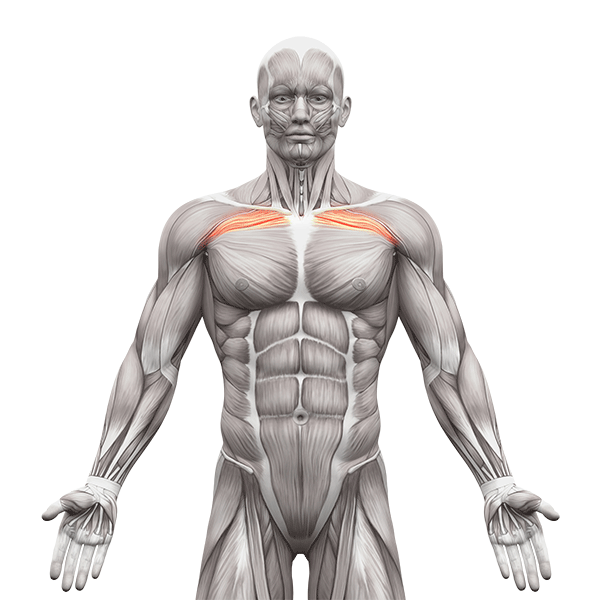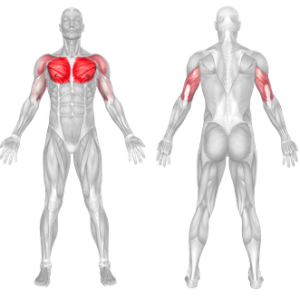Incline Chest Press Machine
The Incline Chest Press Machine is a type of exercise equipment commonly found in gyms and fitness centers. This exercise primarily targets the upper chest muscles, providing a variation to the traditional chest press machine.
The movement on the Incline Chest Press Machine involves pushing the handles forward and away from your body until your arms are almost fully extended, mimicking the motion of a chest press. Then, you slowly return to the starting position by controlling the movement and allowing your chest muscles to stretch.
How to do:
- Sit on the machine with your back firmly against the backrest. Position your feet flat on the floor, shoulder-width apart. Maintain a neutral spine and engage your core muscles for stability.
- Grasp the handles or grips on either side of the machine. Your palms should be facing forward, and your hands should be shoulder-width apart or slightly wider, depending on your preference.
- Starting position: With your arms bent, bring the handles close to your chest. Your elbows should be at about 45 degrees or slightly greater. This is your starting position.
- Movement: Push the handles forward and away from your body, extending your arms fully but not locking your elbows. Exhale as you press the handles away.
- Controlled return: Slowly bring the handles back to the starting position, maintaining control over the movement. Inhale as you return to the starting position, allowing your chest muscles to stretch.
- Repeat: Complete the desired number of repetitions according to your fitness level and goals. Aim for a controlled and smooth motion throughout the exercise.
Incline Chest Press Machine – Benefits
1- Upper chest development: The primary focus of the incline chest press machine is to target the upper portion of your chest muscles.
The incline chest press machine is an exercise that focuses on the upper part of the pectoral muscles and is preferred by beginners as it provides greater stability. Targeting the pectorals, triceps and deltoids, incline bench press machie exercise help to build upper body strength and increase muscle mass.

2- Variation and muscle engagement: Using the incline chest press machine provides a variation to the traditional flat bench press. This exercise activates different muscle fibers and engages the pectoralis major, pectoralis minor, anterior deltoids (front shoulders), and triceps to a greater extent compared to flat bench exercises.
3- Strength and muscle building: The incline chest press machine is an effective tool for building upper body strength and muscle mass. By progressively increasing the weight and challenging your muscles, you can stimulate muscle growth and improve overall strength in your chest, shoulders, and triceps. (Learn how to do a chest workout for mass)
4- Stability and joint support: The machine provides stability and support, especially for individuals who may have difficulty balancing or maintaining proper form during free-weight chest exercises. This can be beneficial for beginners, those with joint limitations or injuries, or individuals seeking additional stability during heavy lifting.
5- Safety and injury prevention: The incline chest press machine reduces the risk of injury associated with using free weights, as it guides your movement along a fixed path and provides controlled resistance. It helps minimize the risk of dropping weights or straining muscles due to improper form or excessive load.
6- Convenience and accessibility: Incline chest press machines are commonly found in most gyms and fitness centers, making them easily accessible for individuals looking to target their chest muscles. They also offer the advantage of quick and easy weight adjustments, allowing you to customize the resistance to your fitness level.
Incline Chest Press Machine – Muscles Worked

- Pectoralis major: The incline chest press heavily activates the pectoralis major, which is the large chest muscle responsible for adduction and flexion of the arm, as well as horizontal flexion of the shoulder joint.
- Pectoralis minor: Although to a lesser extent, the incline chest press also engages the pectoralis minor, a smaller muscle located underneath the pectoralis major. The pectoralis minor assists in stabilizing the shoulder blade and contributes to the movement of the shoulder joint.
- Anterior deltoids: The front part of the deltoid muscles, known as the anterior deltoids, are recruited during the incline chest press. These muscles help in shoulder flexion and assist in the pressing movement.
- Triceps brachii: The triceps, located at the back of the upper arm, act as synergists during the incline chest press exercise. They assist in extending the arm at the elbow joint.
- Biceps brachii: As the biceps attach to the shoulder blade and the upper arm bone (humerus), they play a role in stabilizing the shoulder joint during the pressing movement.
It’s worth noting that the specific muscle engagement can vary depending on factors such as grip width, angle of the incline, and individual biomechanics.
The Bottom Line
Remember that incorporating a variety of exercises and equipment into your workout routine is important for well-rounded muscle development and overall fitness. The incline chest press machine can be a valuable addition to your chest training regimen, but it should be combined with other exercises and training modalities for comprehensive results.

